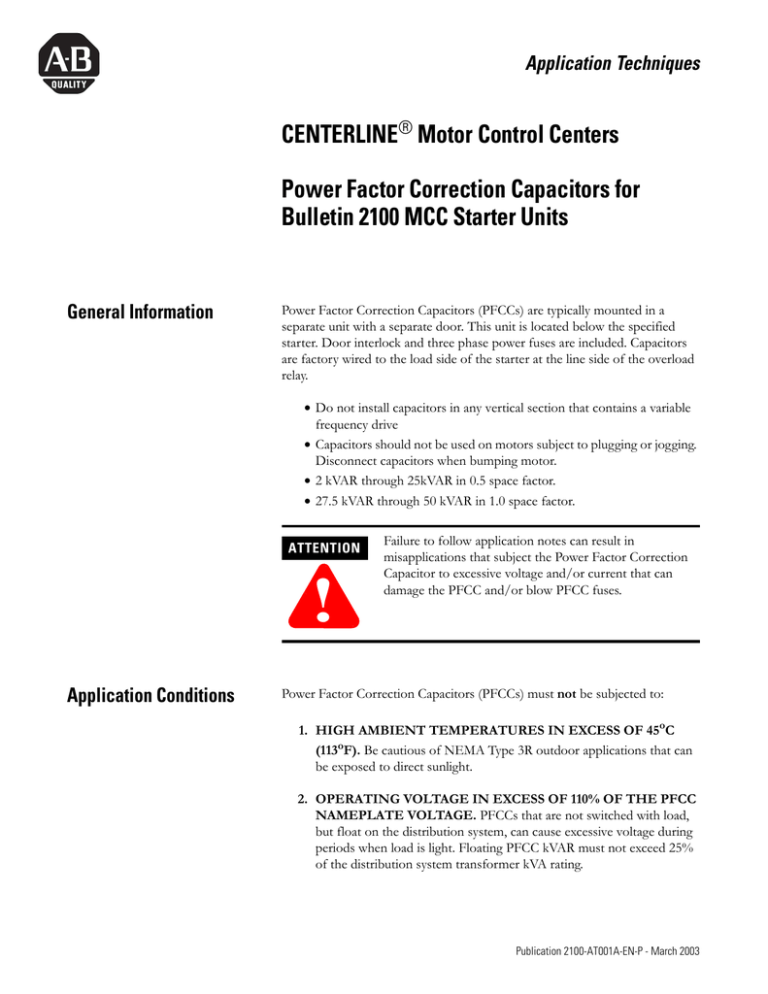
Application Techniques
CENTERLINE® Motor Control Centers
Power Factor Correction Capacitors for
Bulletin 2100 MCC Starter Units
General Information
Power Factor Correction Capacitors (PFCCs) are typically mounted in a
separate unit with a separate door. This unit is located below the specified
starter. Door interlock and three phase power fuses are included. Capacitors
are factory wired to the load side of the starter at the line side of the overload
relay.
• Do not install capacitors in any vertical section that contains a variable
frequency drive
• Capacitors should not be used on motors subject to plugging or jogging.
Disconnect capacitors when bumping motor.
• 2 kVAR through 25kVAR in 0.5 space factor.
• 27.5 kVAR through 50 kVAR in 1.0 space factor.
ATTENTION
!
Application Conditions
Failure to follow application notes can result in
misapplications that subject the Power Factor Correction
Capacitor to excessive voltage and/or current that can
damage the PFCC and/or blow PFCC fuses.
Power Factor Correction Capacitors (PFCCs) must not be subjected to:
1. HIGH AMBIENT TEMPERATURES IN EXCESS OF 45oC
(113oF). Be cautious of NEMA Type 3R outdoor applications that can
be exposed to direct sunlight.
2. OPERATING VOLTAGE IN EXCESS OF 110% OF THE PFCC
NAMEPLATE VOLTAGE. PFCCs that are not switched with load,
but float on the distribution system, can cause excessive voltage during
periods when load is light. Floating PFCC kVAR must not exceed 25%
of the distribution system transformer kVA rating.
1
Publication 2100-AT001A-EN-P - March 2003
2
CENTERLINE® Motor Control Centers Power Factor Correction Capacitors for Bulletin 2100 MCC Starter Units
3. VOLTAGE AND CURRENT WAVEFORMS OTHER THAN 60
HZ SINE WAVES. Non-linear devices that employ solid state
switching technology (AC & DC drives, AC reduced voltage controllers,
arc-type lighting, programmable controllers, computers, induction
furnaces, etc.) produce distorted non-sinusoidal wave forms and
harmonics that can blow PFCC fuses and/or damage PFCCs due to
high current because of reduced capacitive reactance and/or
capacitive-inductive resonance. Do not connect a PFCC to the load side
of a Bulletin 150 SMC controller or any AC Drive.
4. VARIABLE FREQUENCY VOLTAGE THAT CAN BE
PRODUCED BY A MOTOR THAT ACTS AS A GENERATOR
when disconnected from power source, supplied with magnetizing
current from PFCCs connected to the motor stator windings, and
driven by the load at a sufficient and decreasing speed. Be cautious of
fan application in particular. Also be cautious of high inertia loads such
as bandsaws, centrifuges, chippers, hammer mills, etc.
5. REPETITIVE SWITCHING DUE TO JOGGING, INCHING,
RESTARTING, etc. which can occur via two or three wire, automatic
or manual control. Be cautious in the use of protective relays
(B813S-V_) that reset automatically. Be cautious of how
HAND-OFF-AUTO selector switches are utilized and how auto control
devices function. PFCC voltage must discharge to a minimum level
before the PFCC is reenergized.
6. PLUGGING. NOTE: A standard reversing starter could inadvertently
be used to plug a motor by an operator or via a control scheme by
others.
7. OPEN-TRANSITION SWITCHING via reversing and multi-speed
starters and via open-transition type Wye-Delta and autotransformer
starters.
8. INDUCED VOLTAGES AND CURRENTS produced via
transformer action in isolated motor windings connected to a PFCC
while other windings in the same motor are energized, when multispeed
or part-winding motors are utilized. These conditions could be harmful
to the motor and/or cause it to malfunction.
NOTE: As PFCCs might be inadvertantly subjected to these detrimental
application conditions during startup, it is recommended that PFCCs be isolated until the end of the start up process by removing PFCC fuses.
Publication 2100-AT001A-EN-P - March 2003
CENTERLINE® Motor Control Centers Power Factor Correction Capacitors for Bulletin 2100 MCC Starter Units
Alternatives
3
Instead of energizing and de-energizing a PFCC along with a motor, a lighting
contactor can be utilized to connect and disconnect a PFCC to the power
circuit at a point upstream of the controller or starter at the appropriate time
by an appropriate contact or contacts.
If there is no space in the starter for a lighting contactor, a separate Bulletin
2102L or 2103L lighting contactor unit could be utilized.
Each PFCC connected to the power system will add to the capacity of that
power system to increase inrush current to PFCCs subsequently connected to
the power system. Measures may have to be taken to reduce PFCC inrush
current. PFCCs may have to be located further upstream and controlled by
special PFCC switching equipment that might control PFCC inrush current
and/or harmonics in the power system.
For further information, contact the Motor Control Center Business Technical
Support. Contact Technical Support by calling 1-440-646-5800 or by e-mailing
RAMCCSupport@ra.rockwell.com.
Publication 2100-AT001A-EN-P - March 2003
Publication 2100-AT001A-EN-P - March 2003 4
Supersedes Publication 2100-4.3 - May 1997
© 2003 Rockwell International, Inc. All rights reserved. Printed in the U.S.A.





